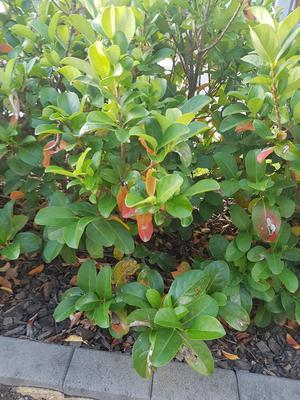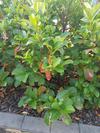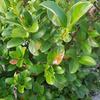
by Leo
(Cobbitty, NSW, Australia)

Viburnum tree 1



Hi,
Thanks for looking into this issue.
I live in Australia in NSW in Cobbitty.
We are into Winter now and over the last couple of weeks in Autumn,My Sweet Viburnums have been showing red leaves over 30+ trees. Per tree i estimate 20 leaves show this colour. Ive had these trees for over 5yrs since planting. 1mtr in height. The temps range from 1 to 5degrees in the night to 15degrees in the day.
My soil is loamy clay and its in full sun for 7hrs a day. Winter its about 5 or 6 hours. I use blood and bone and slow release fertilisers. I actually put potash down during Autumn to strengthen the cells to cope thru winter. Maybe that could be the cause.
I hope you can help with this issue.
Thanks
Leo
Comments for Sweet Viburnum disease or deficiency
Jun 07, 2020
Fertilizer
by: Jacki Cammidge, Certified Horticulturist
So, judging from your pictures, the leaves that are turning red are lower, older leaves, right? This is normal.
Even evergreen plants need to shed old worn out leaves, so that isn’t a problem, that I can see.
If new leaves were showing this issue, then I would worry. I would remove them, once they fall off, especially any that are showing the brown spots, which could be a fungal disease and can reinfect the plant from rain splashing the spores onto the leaves, creating a vicious cycle.
Second thing is that in your soil, it could be that it’s too acidic, having clay in it. This can bind up nutrients, making them unavailable to the plant. The only solution to this is to change the pH, by sprinkling a small amount of wood ashes or Dolomite lime around the plant.
Don’t overdo it, as this can be a delicate balance.
I looked up the various types of deficiencies and toxicities, but the one that didn’t come up in my research is iron toxicity. Maybe get your water tested for this. It doesn’t take much iron to really impact plants in a negative way. Solution? Collect rain water off a non-zinc roof to use on these sensitive plants.
These plants also need good drainage, so if the soil is holding a lot of moisture, this can create a situation where a lot of minerals stay close to the plants roots. That will show in various ways – mostly toxicities.
A solution to most of these issues is to use a compost mulch, which will buffer the soil and make it much more nutrient rich without the use of chemical type fertilizers which just make the soil dead and useless.
Keep a mulch of chopped leaves around the base of the plant – not eucalyptus or any kind of coniferous plant which could add toxicity, not buffer it!

